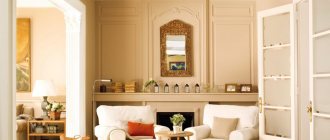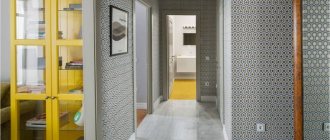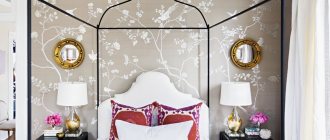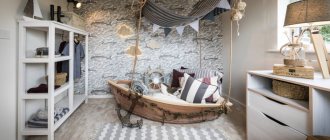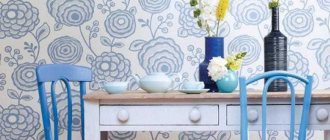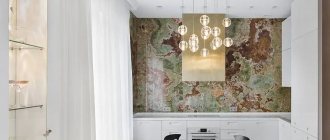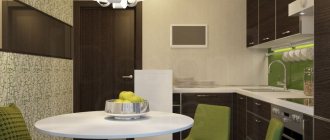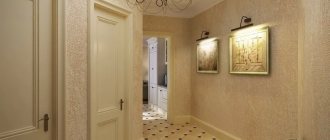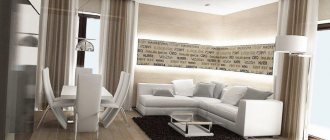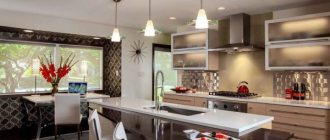Home/Hallway/Liquid wallpaper in the hallway: photos of interiors for an apartment
Liquid wallpaper in the hallway looks impressive not only in photos, but also in real life. This material is suitable for the hallway due to its functionality. They have a rich palette, high strength and resistance to fading. Due to its good density, a liquid coating can be used to smooth out minor wall defects.
Liquid wallpaper can complement any hallway interior
What is liquid wallpaper?
There is no big difference between plaster and liquid wallpaper. According to some masters, liquid wallpaper is a type of decorative plaster. Others believe that the mixture successfully combines the properties of both plaster and ordinary paper wallpaper. Be that as it may, one thing is clear - it is impossible to equate these two concepts. The materials differ not only in texture, but also in the method of application.
One of the ways to apply liquid wallpaper
Liquid wallpaper consists of glue and cellulose fiber. Depending on the design, silk and cotton, various dyes and relief fillers - shavings, sand, granules, mica, etc. can be added to the mixture.
Two-color liquid wallpaper in the interior of the corridor
It is the composition that influences the decor of the wallpaper itself. Colors, textures, patterns - thanks to their diversity, the liquid mixture can be used to decorate a room for any purpose, be it an office, a residential apartment or a public place.
Liquid wallpaper of lilac color in the interior of the hallway
Peculiarities
To unambiguously decide for yourself whether it is worth using such material when decorating the corridor in an apartment, you need to compare the advantages and disadvantages. How do liquid wallpaper compare favorably with its roll counterparts and other finishing materials?
Beige liquid wallpaper in the hallway interior
Advantages
Here are the main advantages of liquid wallpaper for the corridor:
- Resistance to low temperatures, which allows them to be used not only in city apartments, but also in country houses without heating;
- The dye does not fade when exposed to ultraviolet radiation;
- The mixture levels the walls, filling small cracks, depressions, etc.;
- Easy to apply and remove;
- Improve the sound and heat insulation of walls in the house;
- Contains only environmentally friendly hypoallergenic materials that are safe for the health of household members;
- Easy to clean without accumulating dirt and dust;
- They do not allow moisture to pass through or accumulate, and are not susceptible to mold;
- Possibility of use on any surfaces and walls with different designs - inside niches, on ledges, columns, arches, etc.
Liquid wallpaper helps create a laconic interior
Important! For all its advantages, liquid wallpaper cannot hide serious wall defects, so before choosing finishing materials you should carefully examine the surface. If the unevenness is significant, you will need to first level the walls using drywall or plaster.
Decorating a corridor using liquid wallpaper in gray and beige shades
Flaws
There are not many disadvantages to liquid wallpaper in the interior of a hallway, and the advantages definitely outweigh the disadvantages. However, when choosing this material, it is worth considering them:
- Despite the fact that liquid wallpaper does not accumulate moisture, it is afraid of water and is therefore unsuitable for rooms with high humidity. However, thanks to this very property, they can be easily removed from the walls if necessary.
- The wallpaper cannot be washed, only cleaned with a vacuum cleaner or a regular dry cloth. For this reason, they are not suitable for the kitchen area.
- The cost is more expensive than conventional wallpaper coverings.
Drawing “Yin and Yang” in the interior of the hallway using liquid wallpaper
At first glance, cleaning liquid wallpaper is difficult - water washes it away. If there is a stain left on the wall that cannot be removed with a dry cloth, you can apply a little liquid mixture to paint over the dirty area. Only those places that are constantly dirty can cause inconvenience.
The design of flowers on liquid wallpaper adds elegance to the interior.
Recommendations before repair
Here are some useful tips when mixing liquid wallpaper:
- Take exactly as much water as prescribed in the instructions for the mixture;
- The powder is poured into the water, and not vice versa;
- Follow the rule: one container - one package;
- The liquid coating must be mixed manually; using a drill will disrupt the structure of the fibers;
- The finished mixture can be stored for 2-3 weeks if unopened.
Always mix just the right amount for all walls. If there are liquid wallpapers of different mixtures on the surface, this will be visible by the different tone. The amount of material should be calculated based on the following parameters: 1 kg of mixture per 6 m2. If after painting one wall there is a little mixture left, it can be poured into a new solution.
Application process
To apply the mixture to the wall surface you will need:
- Grater;
- Putty knife;
- Spray.
The process of applying liquid wallpaper is carried out as follows:
Place a small amount of solution on a spatula; Apply the mixture to the wall, then rub it with a float until the coating thickness is 3 mm; It is important not to lift the tool from the wall while rubbing, otherwise unsightly seams will remain; While controlling the pressure on the float, continue applying the coating to the wall; The filled area must be leveled so that there are no lumps left; to do this, just moisten the grater and treat the surface with it; Once the mixture is applied to the walls, moisten the spatula in water and run it over the surface again for final leveling.
Liquid wallpaper in the hallway takes 2 to 3 days to dry. To make the process go faster, the room must be well ventilated, so the moisture will evaporate more intensely.
The temperature in the corridor should not be lower than +10 degrees.
Creating a drawing
In the interior of the hallway, liquid wallpaper with a pattern looks great. How to apply your favorite ornament or design:
- Make markings with a pencil;
- Apply the finishing mixture strictly along the lines in the direction from the center to the edge;
- Wait for the drawing to dry (usually this takes about 24 hours);
- Adjust the picture using a rubber spatula, move excess material to the center, and trim unnecessary elements with a sharp knife;
- Before applying the main background, cover the drawing with masking tape.
Different colors and textures on the walls look more impressive than plain coatings, creating a wide variety of compositions on the walls. You can draw waves, stripes, floral patterns, flowers, animals, clouds, etc. in the corridor.
With proper application and care, the liquid coating of the walls in the corridor will last a long time. Such surfaces can be easily changed, refreshing the interior. The variety of shades and textures allows you to create anything, even full-fledged drawings on the walls of the corridor.
Materials
Like roll wallpaper, liquid mixtures are distinguished by a wide variety of shades and textures. In the interior of one hallway, you can combine different types of mixtures, creating entire artistic compositions. Liquid wallpaper can really be used to paint on a wall like paint. This effect is difficult to achieve using conventional roll coatings. So, which liquid wallpaper is best for the hallway?
Luxurious corridor interior created using liquid wallpaper
Based on their composition, decorative mixtures are divided into several types:
- Cellulose. They are made on the basis of ordinary paper, so they get dirty quickly and are sensitive to moisture and steam. Due to its low performance properties, such a material is not suitable for a hallway.
- Silk. The mixture consists of paper and silk fibers. This coating is more durable, but is sensitive to any influences.
- Textured with the addition of stone chips. The most resistant material and best suited for finishing the corridor. However, textured wallpaper has a drawback - its price.
- Combined mixtures. In essence, it is a simple white mass, to which any necessary ingredients, including dyes, are added at your own discretion.
Green silk liquid wallpaper in the hallway
Options for using liquid wallpaper in the interior of the corridor can be seen in the selection of photos below.
Advantages and disadvantages of using liquid wallpaper
Any material has advantages and disadvantages. The main advantage of liquid wallpaper is its ease of application and the absence of the need to prepare surfaces. They will perfectly disguise small chips and cracks on the walls. Using the principle of plaster, the mixture fills all the recesses and hides defects.
According to consumer reviews, they have an attractive appearance and can be of a wide variety of colors and textures. At home, this is achieved by adding color. Any damage can be easily corrected with your own hands if you correctly apply a new mixture to the damaged area. Contaminated areas are removed by a new application of diluted granules.
A room with this decoration will look beautiful. Thermal insulation characteristics of the walls are increased. They are pleasant to the touch even when the room temperature drops significantly. Any type of such wallpaper applied to the walls will have good antistatic properties. Provided high-quality pasting and careful handling, such wallpaper can last up to 20 years.
The disadvantages include the need for additional drying. To quickly evaporate moisture, you will need to ensure good ventilation in the room. In winter, you will need to install additional heating devices in the room. The disadvantages also include the lack of wet cleaning and the high cost of the material.
Finishing
Usually the hallway cannot boast of large dimensions; in typical apartments it is most often a long narrow room. Very rarely there are windows on one of the walls, so the main source of lighting is artificial. For these reasons, it is highly not recommended to use dark colors when decorating this small room.
Too bright shades are also not suitable for decoration; they absorb light, which is why the interior of the corridor may seem unpleasant or too intrusive. You can visually expand the hallway by combining different colors. Dark shades are used at 50 cm from the floor, while the rest of the walls are painted in lighter colors. This technique will not only visually enlarge the space, but will also raise the ceiling.
You can use drawings as decoration. The motives can be anything, from abstraction to entire plots. If you make the mixture very thick, it can be used as stucco on the walls. This is an excellent option for a corridor in a classic style.
Additional Tips
To make your photo wallpaper look as impressive as possible, use the following tips:
- Think about lighting. The drawing may get lost in a dark corner. On the contrary, lighting located in the right places can complement the overall impression of photo wallpaper;
- A mirror sheet on cabinet doors or on the wall will help increase the space, as well as the effect of the pattern on the wall;
- Usually photo wallpapers are self-sufficient. But sometimes additional decorative elements enhance the impression of the design. For example, next to a photo of a boulevard, a bench with a floor lamp in the shape of a street lamp would look appropriate;
- Bright, small-sized photo wallpapers can be framed to become an interior decoration.
Small photo wallpapers can be framed to become an interior decoration.
Many people want to make their hallway interesting and memorable. Photo wallpapers are an excellent option for them due to their effectiveness, ease of installation and accessibility.
Color spectrum
To decorate walls in a small room, it is better to choose light shades. Bright colors can also be used, following a number of rules. They can be combined with neutral tones, creating patterns in the form of stripes on the surface, or you can accent one of the walls.
In the interior of the hallway, the combination of white with shades of yellow looks fresh; this range will make the room lighter and more cheerful. Plain coverings of beige or milky color will highlight stylish furniture and emphasize decorative elements. If you want to bring a little coolness to the interior, you can use a blue color scheme.
Red tones, combined with gray, will help visually change the shape of the room. If there is a window in the hallway, a combination of brown and purple will look good. The high-tech style in the design of the corridor is emphasized by metallic shades complete with white or black. But completely brown walls are good as a background for furniture made of light wood. How different shades of liquid wallpaper affect the appearance of the interior of the corridor in the apartment can be seen in the photo below.
Stylistic decisions
Stylish hallway design, bright and cozy.
Despite the wide variety of wallpaper for the hallway, when its design is formed, factors such as the parameters of the room, its layout, and the level of illumination are taken into account
Wallpaper for the hallway in a classic style
Classic style in the hallway, wallpapering the walls.
The classic style is ideal for solid people inclined to conservatism. This style is characterized by symmetry of compositions and sometimes pompous decoration. Wallpaper for a hallway in a classic style should be in muted shades. If the choice falls on the presence of prints, then all patterns should be symmetrical. White, beige, green and brown tones are optimal for this style. Depending on the general concept of the style, finishing material with vertical or horizontal stripes, as well as with oriental patterns, is suitable.
Wallpaper for the hallway in a modern style
Modern style for wallpaper in the hallway.
Modern interior style provides the opportunity to find that niche of creativity characteristic of each individual case. Many people make the mistake of not fully understanding the direction of the style. In fact, there are many modern stylistic trends.
The Art Nouveau style, despite its name, loves elegance and is distinguished by aristocratic lines. It combines classical foundations and new ideas. Therefore, ideally and if the general concept of the hallway design allows, one wall can be plain, and the other can be highlighted with wallpaper with a large pattern, which, at the same time, should be laconic and discreet. Optimal for modernism are also photo wallpapers that visually increase the area.
The glossy shine of metal and glass is the hallmark of the high-tech style. Using glass and mirror finishing items, you can also save space. Given the trend of self-leveling floors, preference in wall decoration is given to fiberglass or metal wallpaper.
Wallpaper for the hallway in Provencal style
Provence style is airy and elegant; wallpaper with a floral pattern is suitable.
Checkered wallpaper, small flowers with a blue tint, the absence of bright, contrasting tones - all this is inherent in the Provencal style, which is loved by many thanks to its comfort and French charm.
Wallpaper designs can be combined by combining brown, blue, snow-white and yellow shades. “Uncomplicated” at first glance, the interior of the hallway is actually thought out to the smallest detail. The only condition for creating a harmonious image is the absence of olive, lavender and any dark color.
Wallpaper for the hallway in Scandinavian style
The Scandinavian style is characterized by cool shades and predominantly white.
Connoisseurs of minimalism prefer to furnish their home in a Scandinavian style, therefore, the hallway of a house or apartment should correspond to it. Scandinavian countries are a cold territory, which is why in the palette when choosing wallpaper, preference is given to cold shades. The classic colors are white and gray.
What materials can be combined with?
Liquid wallpaper in the hallway can be easily combined with its roll counterparts - paper, vinyl or fabric. With the help of roll wallpapers that are contrasting in color and have excellent texture, it is easy to create inserts to attract attention to a particular interior detail. It is worth considering that paper wallpaper is the most fragile and short-lived option, so you should not choose them for the hallway.
In interiors in country or classic style, a combination of liquid coatings with panels made of cork oak, bamboo and other types of wood looks good. The advantages of this coating are hypoallergenic, lack of unpleasant odor and environmental friendliness. Wooden panels are strong and reliable, however, like liquid wallpaper, they do not tolerate high humidity.
Decorative plaster goes well with liquid wallpaper due to the similarity of texture. This is a strong and durable coating. However, when using plaster mixtures, it is important to ensure that the coating layers are the same in thickness. By choosing different color combinations, liquid wallpaper and plaster can be blended into any hallway interior style.
Important! Since liquid wallpaper itself is textured, you should not overload the hallway walls with a large number of decorative elements. An abundance of decor will overload the interior or visually narrow the space.
Types of wallpaper
You can choose wallpaper from the following options:
Washable vinyl wallpaper (vinyl)
An ideal option for a variety of textures to hide uneven surfaces. However, it is possible to damage the vinyl layer.
Quartz wallpaper
This coating in the form of quartz sand is applied to a non-woven base. They have a unique wear resistance, are not subject to mechanical stress, and are easy to maintain. Can be painted with latex paint as needed.
Glass wallpaper
These are peculiar panels that are made on the basis of glass fibers. They have high strength and wear resistance, are not susceptible to mechanical and chemical influences, but they are impervious to moisture.
Liquid wallpaper
They have the following properties: wear resistance, sound insulation, high strength, elasticity. They are resistant to moisture, mechanical stress, and can withstand repeated staining.
Bamboo wallpaper
Environmentally friendly coating with excellent thermal and sound insulation. Not subject to mechanical stress, easy to maintain.
However, application is difficult and requires preliminary preparation of the base. Regular wallpaper glue will not work, so you need to purchase a special adhesive.
In addition to the characteristics of the wallpaper material, you should pay attention to the design
How and with what to combine
The methods for combining liquid wallpaper are practically no different from conventional roll coatings. For the most part they are divided into:
- Vertical combination visually raises the ceilings, but does not look good in too small and narrow corridors. If the area of the room is too small, it is better to leave vertical stripes on only one of the walls or choose a separate area.
- Horizontal combination, on the contrary, allows you to expand the room, but visually lowers the level of the ceilings. You should use horizontal stripes with caution on long walls if the hallway is rectangular in shape.
- Decorative inserts. Most often, liquid wallpaper is combined with vinyl or non-woven fabrics. Inserts can be further highlighted using decorative frames, moldings or stucco.
Accent walls in hallway interiors are created extremely rarely. Most often, this technique is used in rooms that are quite spacious or combined with a living room.
Colors
When choosing liquid wallpaper, you should take into account the lighting in the room: if the room is well lit, then any colors will do, but if the room is quite dark, then choose exclusively light colors. Also, light pastel colors will help visually expand the space. A combination of several colors and textures will allow you to create an original design even in such a boring part of the apartment as the corridor.
If the hallway is dark, then combining yellow and white colors will change the room, adding light and brightness. If you need to add “freshness,” use blue and blue shades. A combination of red and gray colors will correct the unsuccessful shape of the corridor.
You can choose any desired color from the rich palette presented in the store or mix your own using a tint. Keep in mind that bright shades are used for accents, while soft and light ones are used for background decoration. It is possible to choose a powder with decorative additives: gold threads or sparkles, silk and cotton, granules, bark, dry algae, sand or mica.
If you give preference to white, the corridor will very quickly lose its attractive appearance and aesthetics. Soft orange shades will lift your mood just like yellow ones. Green colors usually have a calming effect, but it is quite difficult to find suitable hallway furniture for them. Variegated wallpaper, consisting of a light background and a dark pattern, will retain its appearance for a long time.
How to prepare for gluing
Preparing the liquid mixture takes from 6 to 12 hours; you can mix the wallpaper at the stage of leveling and priming the walls. Mixture components:
- Paper or silk base;
- Dyes;
- Fillers (glitter, granules, stone chips, etc.);
- KMS glue.
All components can be purchased separately or ready-made. The ingredients must be poured onto pre-spread polyethylene measuring approximately 100x150 cm. Mix the resulting mixture thoroughly and beat it well to avoid the appearance of lumps. First of all, the decorative mixture is poured into the water, and then the remaining ingredients, this will ensure even distribution of the coating.

